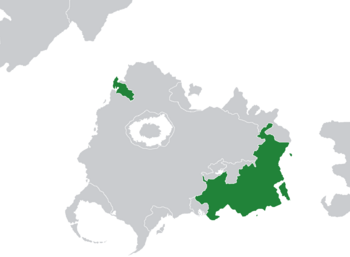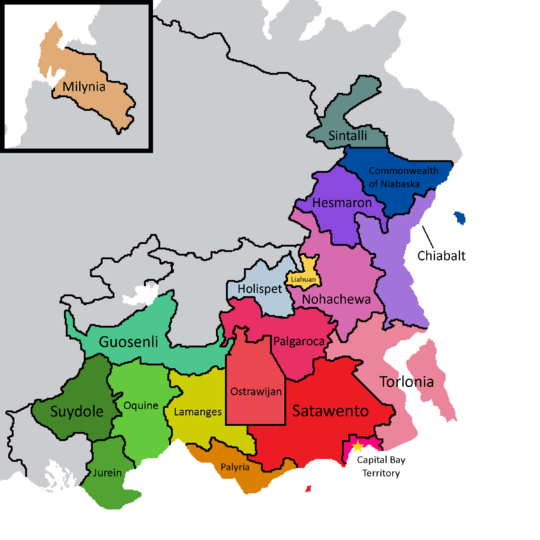Scalizagasti
This article is incomplete because it is pending further input from participants, or it is a work-in-progress by one author. Please comment on this article's talk page to share your input, comments and questions. Note: To contribute to this article, you may need to seek help from the author(s) of this page. |
Republic of Scalizagasti | |
|---|---|
|
Flag | |
Motto: Long live free Scalizagasti! | |
 Location of Scalizagasti in the world | |
| Capital and largest city | Bewundal |
| Official languages | |
| Ethnic groups (2016) |
|
| Religion |
|
| Demonym(s) | Scalizagastian |
| Government | Federal parliamentary republic |
• President | Siobhan Bergmann |
• Prime Minister | Sarah Millard |
| Legislature | Parliament |
| Establishment | |
• Empire of Scalizagasti | 5 June 1767 |
• Republic of Scalizagasti | 7 August 1841 |
| Area | |
• Total | 2,353,551 km2 (908,711 sq mi) |
• Mainland | 2,233,456 km2 (862,342 sq mi) |
| Population | |
• 2020 census | 82,250,524 |
• Density | 34.95/km2 (90.5/sq mi) |
| Currency | scaliz ($) (SCZ) |
| Driving side | right |
| Internet TLD | .sg |
Scalizagasti, officially known as the Republic of Scalizagasti, is a nation located on the continent of Huitztlanecuilt in the Great Experiment. It shares a border with Samoria, Texcolga, and Hapria to the north, borders Nishfund to the west, and borders neutral territory elsewhere.
Etymology
WIP
History
Ancient and classical Scalizagasti
Medieval Scalizagasti
The Kingdom of Scalopya was founded by King Taejo the Great in 802. The kingdom, named after the Scalopyan tribal confederation, would last until its collapse in the 13th century. The numerous tribes and kingdoms from the classical era were unified under one banner, and the resulting stability led to a golden age for Scalopyan society. There were many great advancements into science, literature, the arts, religion, and culture.
The period following the collapse of the Kingdom of Scalopya is known as the Three Kingdoms Period. The Kingdoms of Satawento, Jurein, and Hesmaron were rivals of similar strength and size, constantly competing for dominance over land and vassal states. Some independent states also existed in this era, including the Kingdom of Liahuan and the Maldati Confederation.
Reunification and Imperial Era
King Valéry III, the ruler of Satawento, was an ambitious ruler who sought the recreation of Scalopya which had fallen five centuries before his birth. While other leaders from the Three Kingdoms Period had attempted similar feats, the balance of power in the region made conquest of any of the great kingdoms nearly impossible. In 1759, the Ten Weeks' War between Satawento and Hesmaron resulted in a decisive victory for Satawentan soldiers, giving them control of northern Torlu, Niabaska, and Blicamy. The war was a strategic move of the part of Valéry, who correctly believed that Jurein would not intervene due to internal political issues. In 1760, King Valéry invaded Hapria after King Theomenic annexed the duchies of Answel and Pretezzo, which Satawento claimed violated the Dannesbirg Agreement of 1699. Satawento quickly captured the Haprian capital of Nems, and in the resulting Treaty of Nems they annexed the southern territory of Holispet and took control of Answel and Pretezzo as their own duchies.
The Empire of Scalizagasti was officially proclaimed on 5 June 1767, where Valéry of Satawento was named Emperor of Scalizagasti.
Modern Scalizagasti
Politics
Government
The Republic of Scalizagasti is a federal parliamentary republic governed by the Constitution of Scalizagasti. The Constitution came into effect on 7 August 1841, the same day that the Treaty of Maldati was signed. The President of Scalizagasti is elected every seven years by the electoral college and serves as the head of state. Although the President must sign any bill before it may come into effect, the role is largely ceremonial and the President almost never vetoes a bill unless it is unconstitutional. Prior to the Scalizagastian Civil War in 1872, Scalizagasti was a semi-presidential republic with a president elected separately from the unicameral legislature. The Prime Minister of Scalizagasti is the head of government and leads the executive branch of Scalizagasti's government. The Prime Minister is chosen by the legislature, usually the leader of the party that commands a majority of seats or leads the largest coalition.
The Scalizagastian Parliament is the unicameral legislature of Scalizagasti. The Parliament has 516 seats which are elected every four years with an open list proportional electoral system in multi-member districts. As of 2021, there are 52 electoral districts which range from 5 to 19 seats.
Prior to the Scalizagastian Revolution, Scalizagasti was a monarchy with very limited democratic representation. During the times of the Empire, Scalizagasti had a bicameral legislature with the lower Imperial Assemby and upper Imperial Senate. The Imperial Chancellor was the head of government and acted like the modern Prime Minister, but had little de facto power as the monarch had complete veto powers and could dismiss the government at any time.
The Revolutionary Republican Party is the oldest active political party in Scalizagasti. Due to its role in the Scalizagastian Revolution and founding of the Republic, it enjoys widespread popular support during elections. Because it commonly forms government, the party is sometimes referred to as Scalizagasti's "natural governing party." In the 20th century the RRP formed government for over 70 years.
There are three main political blocs in Scalizagastian politics. Historically, the big-tent RRP occupies the centre of the political spectrum, also including voters and politicians from the centre-left and centre-right. The left wing is led by the Social Democratic Party which has formed seven governments since 1912. Recently, the Greens have also emerged as a signficant force in the Scalizagastian left, forming Official Opposition in 2012. The right wing is represented by the New Scalizagasti Party (which formed government in 2008 and 2012) and the Liberal-Conservative Alliance (which formed government in 2005). The Aulden Democratic Party was historically the largest centre-right party, but declined during the 1970s and 1980s and currently has a rump caucus of 5 seats.
As of the 2020 election, the Social Democratic Party led by Sarah Millard governs Scalizagasti with support from the Greens. The next election is scheduled for 9 August 2024.
Provinces and Overseas Territory
Scalizagasti is a federation comprised of seventeen provinces and two territories. As part of a federal system, the provinces are largely autonomous with respect to their internal organization. Provinces derive their power from the Constitution of Scalizagasti, and control aspects like healthcare and education. Likewise, the federal government is in charge of other aspects of government such as foreign affairs and banking. Territories, meanwhile, derive their power from the federal legislature and their status can be changed by Parliament. The issue of jurisdiction is vitally important to Scalizagastian democracy, and there have been numerous legal cases regarding it.
Foreign Relations
Scalizagasti maintains warm relations with its neighbours as part of the East Freimercia Association of Nations (EFAN), which includes Hapria and Texcolga. It was founded in 1956, seven years after the end of the Second Scalizi-Haprian War to prevent outbreak of another war in the region. As a middle power, Scalizagasti cooperates with all of its neighbours and nearby countries.
Scalizagasti is not a member of the Ussestelhke Alliance (UA) but maintains relations with its members. Scalizagasti's military participates in peacekeeping operations, including alongside UA military operations. During the Nightcrestian crisis, UA and Lavorean forces were supported with Scalizagastian volunteers and peacekeepers.
Economy
WIP
Demographics
WIP
Culture
WIP

